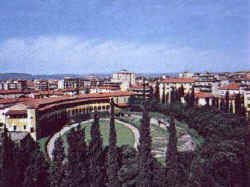Vacation Packages
Arezzo vacation packages
arezzo Hotels
- Arezzo luxury hotels 5*:
- Arezzo first class hotels 4*:
- Arezzo budget hotels 3*:
- Selection of gut rated hotels in Arezzo:
Arezzo is largely frequented by visitors interested in its typical economical and cultural aspects: a world-famous and internationally well-known gold & clothing industry, handicraft and the International Polyphonic Competition "Guido d'Arezzo".

Arezzo vacation packages

The Cathedral, built between the late 13th and the early 16th centuries, is one of the city's most famous architectural monuments. This delicate yet austere example of Tuscan Gothic contains valuable works of art, among them a "Magdalene" by Piero della Francesca and stained glass windows by Guglielmo de Marcillat.
Near the Cathedral, in Piazza della Liberty we can see the Town Hall, built in 1337 and which was originally a tower-house; the only part remained of the original 14th century structure is that facing Via Ricasoli. Before leaving the highest part of the city, go down Via Sassoverde to the Church of S. Domenico, a Ghotic basilica founded in1275 and finished at the beginning of the 14th century, which has a bell-gable with two bells hung in, and where you find an interesting Crucifix by the young Cimabue (1240-1302). This crucifix has a strong sense of form: Christ, in the pangs of death and mastering the contorted position of his body (Byzantine in style), appears to shrink, stoop and stiffen in the last dramatic moments of his life; the Virgin Mary and St. John the Evangelist seem to bow their head and suffer together with Christ.
Santa Maria della Pieve (12th and 13th centuries) is the largest and most beautiful Romanesque church in the Arezzo region and certainly the most characteristic that sprang up in the city during the period of its independence, its tower of "a hundred holes" (so called its many double mullioned windows) is the emblem of the city.
The sumptuous decoration of the fanade and the apse is tempered by the prevailing severity of the spacious interior. Behind the church is the Piazza Grande where on the first Sunday of September every year is held the Joust of the Saracen (Giostra del Saracino, in which mounted knights representing the four districts of the city tilt at the wooden effigy of a Turk. Two sides are occupied by medieval houses and towers, partly restored. The rest of the square is dominated by the rear elevation of the church and the Palazzetto della Fraternita (14th-15th-16th centuries), the palace of a lay fraternity, on the third side; and the impressive mass of the pillared Loggiato del Vasari on the fourth side.
After the Archaeological museum and the Roman Amphitheatre, going towards Guido Monaco square and walking along the street bearing the same name, we find ourselves in front of the Church of S. Francesco in the homonymous square. This church, started in the second half of the 13th century from the Franciscan monks and completed at the end of the 14th century, in the course of the 15th and 16th century was adorned with shrines, chapels and frescoes; however, the attention of the visitor is attracted, above all, by the fascinating scene of the 10 panels of the Legend of the True Cross, painted by Piero della Francesca. This painter, born in the Province of Arezzo, Borgo San Sepolcro, probably in 1415, painted this famous cycle of frescoes, one of the most significant works of Italian Renaissance painting, between 1453 and about 1464; they have been recently restored and you can book your visit applying to the tourist office.

Tags: Arezzo travel guide, vacation rentals, hotels, package holidays, points of interest, car rental, city breaks, weather